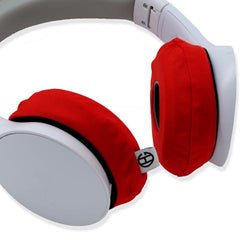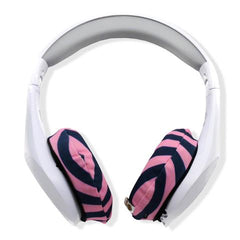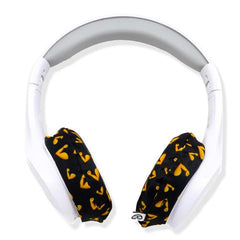What Are Headphone Covers Made Of?

What Are Headphone Covers?
Headphone covers are removable fabric sleeves that sit over the cushions of your headphone to protect the earpad from dirt, sweat, make-up and moisture.
They can be purely functional or they can add colour or design to the earpad as an expression of the wearer’s personality. Headphone covers can make a great accessory and they’re quick and easy to put on and take off.
Why Buy Headphone Covers?
Headphone cushions are usually made from either real or synthetic leather. Real leather is more expensive but, over time, is as vulnerable to wear and tear and sweat-damage as those made from synthetic materials. Headphone covers provide a barrier between the ear of the person wearing them and the earpad’s cushion.
You can buy headphone covers that are purely hygienic. You’ll see these in some industries and workplaces where headphones or headsets are shared between multiple people.
You can also buy headphone covers that protect against sweat-damage. These are popular with gym-users and fitness fans because moisture can cause headphone cushions to crack and peel. Think about how much you sweat when you work out.
Where does that moisture go?
This degradation of material happens Bose and Beats as well as to lower-spec headphones.
Peeling, cracking and tearing can also be caused by the headphones flexing as they’re put over the ears. Over time, weak spots can develop into abrasions on the leather. You can help reduce the risk of this happening by being careful with how you wear your headphones. By doing this and adding sweat-proof covers to the cushions, you’ll have a better shot at keeping your headphones looking newer for longer.
Covers can also prevent dirt and makeup being transferred from a person’s ears and face onto the cushions. Machine-washable, they’re hygienic, too.
What Are Headphone Covers Made Of?
Sweat-resistant headphone covers are often a mix of man-made fabrics. EarHugz use Max-Dri technology which is a spandex and polyester mix. It’s hypoallergenic, quick-drying and machine washable.
You can buy other headphone covers that are made from cotton.
You might recognise them from old aviation movies: the white material stretched over the earpads of a pilot’s headset. Cotton is breathable and washable but it retains moisture so whilst it’s fine in a cockpit (unless you’re Ted Striker in 1980’s movie Airplane!), it’s less suitable for wearing in the gym.
In some industries, you’ll also see disposable headphone covers. These are in environments where people are expected to share headphones, headsets or ear defenders. They’re a thin plastic (sort of like a small shower cap) and are primarily there for hygiene. You probably wouldn’t wear these in your daily life, however as they’re the headphone equivalent of plastic gloves.
How do Headphone Covers Work?
Basic cotton headphones and plastic disposable covers are pretty self-explanatory. They are used primarily for hygiene.
Moisture-wicking headphone covers are far more proactive at protecting cushions from different kinds of damage.
Moisture-wicking fabric is made from synthetic materials like nylon, polyester and spandex. Merino wool is actually moisture-wicking, too, but you probably don’t want to be wearing that to the gym.
Moisture-wicking material is used in a lot of sportswear; its wide surface area means that sweat moves quickly to the outer layer where it’s then easily evaporated.
Known as capillary action, it’s the same principle as a candle drawing wax up the wick to burn.

Unless you’ve bought a sports-specific pair of headphones or you’re wearing UA Project Rock headphones, then your headphone cushions aren’t moisture wicking alone. Sweating on your cushions is bad news. Headphone covers provide a barrier between the two.
Do I Need Headphone Covers?
If you’re working out in headphones, then we’d definitely recommend that you buy sweat-proof covers. Sweat damage not only peels and cracks the material on the earcups, but it leaves the cushions smelling like unwashed gym shorts.
Moisture-damage shortens the life of your headphones, so it’s far cheaper and easier to buy reusable covers than a completely new pair of cans.
We don’t just sweat when we exercise. If you live in a hot or humid country (of if you’re heading somewhere on holiday that is), then protecting your cushions from sweat probably isn’t such a bad idea.
Commuters and travellers should find that headphone covers protect their earpads from makeup and dirty marks. General wear and tear are to be expected but covers could be one way of keeping your cans looking newer for longer.
If you have white headphones, then be aware of how and where you store them. We’d advise out of direct sunlight (and preferably inside a case) because UV can turn white to a pale yellow. White is always going to show up dirt more visibly than black or grey, and covers can help keep them keep their colour for longer.
Most headphones look vaguely similar: in grey, silver or black with rounded curves, sharp lines and subtle buttons. For anyone who wants to add some colour, then headphone covers can be a great accessory. They make a great gift for someone, too.
What if I Don’t Want HF Covers to Ruin the Look of My Headphones?
We get that.
There are some good-looking headphones on the market right now, and you don’t want to upset a bold design with an ill-suited accessory.
EarHugz have some brash and colourful designs, sure, but there’s some subtle and altogether lowkey cover designs, too.
Sentinel for example, wouldn’t distract from the Bose QC II. The Matrix wouldn’t distract from a Sony WH1000 XM3.
All EarHugz are fully-reversible, too. Flip them inside out and they have a plain grey design.
Headphone covers protect headphone cushions from moisture, dirt and damage. Worn to stop the face and ears from rubbing against the earpad, they prevent the transfer of sweat, oils and makeup onto the fabric.
Pick your favourite design from the EarHugz store and tell us why 😊








